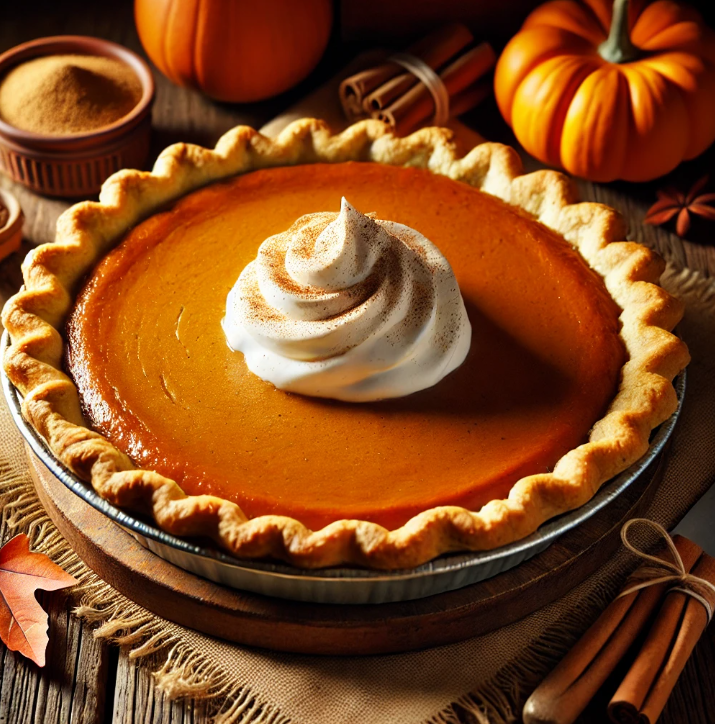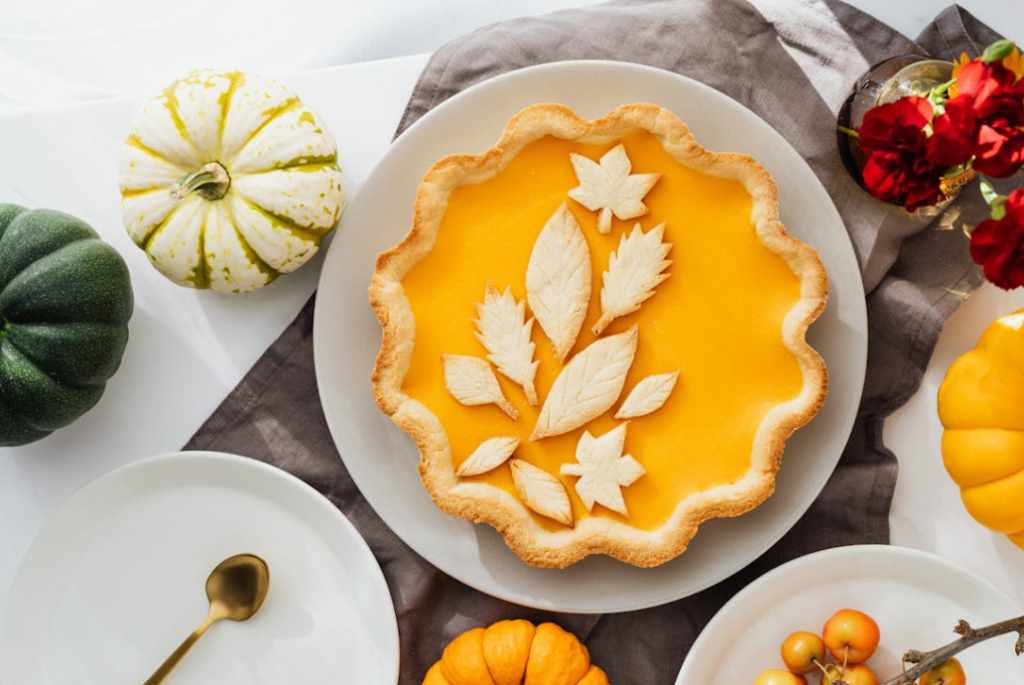Pumpkin pie is more than just a dessert—it’s a symbol of fall, family gatherings, and holiday traditions. From its warm, spiced filling to its flaky crust, this timeless treat has captured hearts for generations. In this article, we’ll dive into everything you need to know about making the perfect pumpkin pie, from essential ingredients to baking tips and creative variations. Whether you’re a seasoned baker or a first-timer, this guide will help you craft a pie that’s as beautiful as it is delicious.
Table of Contents
Introduction to Pumpkin Pie
A Timeless Dessert for Fall and Beyond
Pumpkin pie is a quintessential fall dessert that graces tables during Thanksgiving, Christmas, and cozy autumn evenings. Its rich, creamy filling, infused with pumpkin spice, offers a flavor that’s both nostalgic and comforting. While it’s most popular in North America, pumpkin pie has found fans worldwide, thanks to its unique blend of sweetness and spice.
This dessert is versatile, too. Whether served warm with a scoop of vanilla ice cream or chilled with a dollop of whipped cream, pumpkin pie never fails to impress. Its ability to adapt to dietary needs and preferences makes it a crowd-pleaser in every sense.
Why Pumpkin Pie is Loved Around the World
The love for pumpkin pie goes beyond its taste. Its ingredients—pumpkin, cinnamon, nutmeg, and cloves—evoke the essence of fall. Beyond its flavor, pumpkin pie represents tradition, family, and gratitude. Its simplicity and elegance make it a staple on holiday tables and a go-to choice for festive gatherings.
Ingredients for the Perfect Pumpkin Pie
Essential Ingredients for the Filling
The heart of any great pumpkin pie is its filling. To achieve that rich, velvety texture, start with high-quality ingredients:
- Pumpkin Puree: Canned pumpkin is a popular choice for its consistency, but fresh pumpkin puree can add a subtle, earthy flavor.
- Eggs: These are crucial for binding the filling and creating a custard-like texture.
- Sweetened Condensed Milk or Heavy Cream: Both options bring creaminess, with condensed milk adding sweetness and richness.
- Pumpkin Pie Spice: A blend of cinnamon, nutmeg, cloves, and ginger gives the pie its warm, signature flavor.
Choosing the Right Crust: Store-Bought vs. Homemade
The crust is the foundation of your pumpkin pie. A homemade pie crust, made with butter or shortening, offers a flaky, melt-in-your-mouth texture that complements the creamy filling. If you’re short on time, store-bought crusts are a reliable alternative, but pre-bake (blind bake) them to avoid sogginess.
Spices and Flavor Enhancers for the Best Pie
Spices are what make a pumpkin pie shine. Beyond pumpkin pie spice, consider adding a pinch of cardamom for depth or a splash of vanilla extract for a touch of sweetness. If you prefer a slightly tangy flavor, a teaspoon of orange zest can brighten the filling beautifully.
Step-by-Step Guide to Making Pumpkin Pie
Preparing the Pie Crust
- Roll out your pie dough and press it into a 9-inch pie dish. Trim and crimp the edges for a polished look.
- For a crisp crust, blind bake it. Line the crust with parchment paper, fill it with pie weights or beans, and bake at 375°F (190°C) for 10 minutes. Remove the weights and bake for another 5 minutes.
Creating the Silky Smooth Pumpkin Filling
- In a large mixing bowl, whisk together pumpkin puree, eggs, and your choice of sweetened condensed milk or heavy cream.
- Add pumpkin pie spice, sugar (if using heavy cream), and a splash of vanilla extract. Mix until smooth and well combined.
- For an extra creamy filling, let the mixture sit for a few minutes, allowing bubbles to settle before pouring it into the crust.
Baking Tips for a Perfectly Set Pie
- Pour the filling into the pre-baked crust, spreading it evenly.
- Bake the pie at 375°F for 45–50 minutes. The center should jiggle slightly when gently shaken—it will firm up as it cools.
- Allow the pie to cool on a wire rack for at least 2 hours before slicing. This step ensures the filling sets properly and slices cleanly.
Variations
Gluten-Free and Dairy-Free Pumpkin Pie Options
For those with dietary restrictions, making a gluten-free or dairy-free pumpkin pie is easier than you might think. Replace traditional pie crust with a gluten-free version, made from almond or oat flour, for a nutty and wholesome base. To make it dairy-free, swap the condensed milk or heavy cream with coconut milk or a non-dairy creamer. These alternatives maintain the creamy texture while adding subtle flavor variations.
Mini Pumpkin Pies: Fun and Individual Servings
Why not make it bite-sized? Mini pies are a delightful option for parties or individual servings. Use muffin tins or tart pans to create personal-sized pies. These are not only cute but also easier to serve, especially at gatherings. Add a sprinkle of cinnamon sugar on top for extra charm.
Adding Unique Twists: Chocolate, Bourbon, or Pecans
For a modern twist, elevate it with unexpected flavors. A layer of melted chocolate or a splash of bourbon in the filling brings a luxurious richness. Topping the pie with candied pecans or caramel sauce adds texture and sweetness, making it truly indulgent.
For another creative pumpkin dessert, check out this recipe for Pumpkin Cheesecake Brownies. It’s a fusion of pumpkin, chocolate, and cheesecake that’s hard to resist!
Storing and Reheating
How to Properly Store Your Pumpkin Pie
To keep your it fresh, store it in the refrigerator after it cools completely. Cover it tightly with plastic wrap or aluminum foil to maintain its moisture and flavor. Properly stored, the pie will stay fresh for up to four days. If you need to keep it longer, freeze it. Wrap individual slices in plastic wrap, then place them in a freezer-safe container for up to two months.
Best Methods for Reheating Without Compromising Texture
Reheating it correctly ensures it tastes as good as when it was freshly baked. Avoid microwaving, which can make the crust soggy. Instead, warm slices in the oven at 350°F (175°C) for 10–15 minutes. Cover the edges with foil to prevent over-browning. Serve it warm with a dollop of whipped cream for that fresh-from-the-oven feel.
The History of It
Pumpkin Pie’s Origins in American History
It has deep roots in American history, dating back to the early colonial period. Pumpkins were a staple crop for Native Americans and an essential food source for early settlers. While the first pies may have been crude—a hollowed-out pumpkin filled with milk, honey, and spices—they laid the foundation for the dessert we love today.
By the 18th century, it began appearing in cookbooks, often made with a flaky crust and a spiced custard filling. It quickly became a symbol of harvest celebrations and was popularized as a Thanksgiving tradition, especially in New England.
How Pumpkin Pie Became a Holiday Staple
The connection between it and Thanksgiving solidified in the 19th century, thanks to the influence of writers like Sarah Josepha Hale. Her advocacy for a national Thanksgiving holiday emphasized the dish as part of the festive meal, cementing its place on holiday tables. Today, it remains an iconic symbol of gratitude, family, and the flavors of fall.
FAQs About Pumpkin Pie
Can I Use Fresh Pumpkin Instead of Canned?
Yes, you can use fresh pumpkin, but it requires extra preparation. Start by roasting a sugar pumpkin, then puree the flesh until smooth. Fresh pumpkin often has a lighter, more natural flavor compared to the consistency and convenience of canned.
Why Does My Pie Crack While Baking?
Cracks in it occur when it’s overbaked or cooled too quickly. To avoid this, bake until the edges are set, but the center still jiggles slightly. Cool the pie slowly on a wire rack to prevent sudden temperature changes.
What’s the Best Way to Serve Pumpkin Pie?
Serve it chilled or at room temperature, topped with freshly whipped cream. A sprinkle of cinnamon or a drizzle of caramel adds a decorative and flavorful touch. Pair it with coffee or spiced tea for the perfect fall treat.
Would you like to proceed with additional content or a conclusion?
Conclusion: Why Pumpkin Pie Remains a Classic
There’s a reason why it has stood the test of time—it’s comforting, versatile, and undeniably delicious. This iconic dessert represents the flavors of fall, bringing warmth and nostalgia to every bite. Whether you stick with the classic recipe or explore creative variations, it’s a dish that never fails to impress. From its humble beginnings to its place as a holiday staple, pumpkin pie embodies tradition and togetherness. So, the next time you’re planning a festive menu or simply craving something sweet, let this timeless treat take center stage on your table. It’s a slice of history—and pure happiness!
Additional Tips for Perfect Pumpkin Pie
How to Personalize Your Pumpkin Pie
Make it truly your own by experimenting with flavors and textures. Add a touch of maple syrup or molasses to the filling for deeper sweetness. Incorporate a layer of crushed ginger snaps or graham crackers into the crust for added crunch. A sprinkle of sea salt on top can also enhance the richness of the pie.
Serving Suggestions to Elevate the Experience
For a unique presentation, garnish your pie with sugared cranberries or toasted pecans. Serving it alongside a dollop of cinnamon-spiced whipped cream or a scoop of vanilla ice cream takes it to the next level. If hosting a gathering, consider offering mini pies or tartlets for individual servings—they’re as convenient as they are charming.
With these tips, you can turn it into a standout dessert that leaves everyone asking for seconds. Let me know if you’d like additional inspiration or recipe ideas!
For more delicious casserole recipes and creative meal ideas, be sure to check out AllRecipes.



5 thoughts on “Pumpkin Pie: The Ultimate Guide to a Classic Dessert”